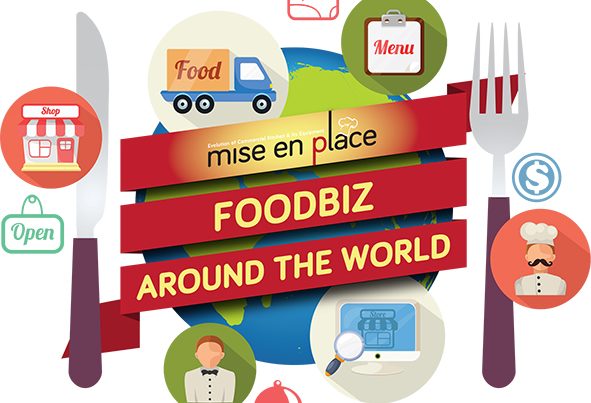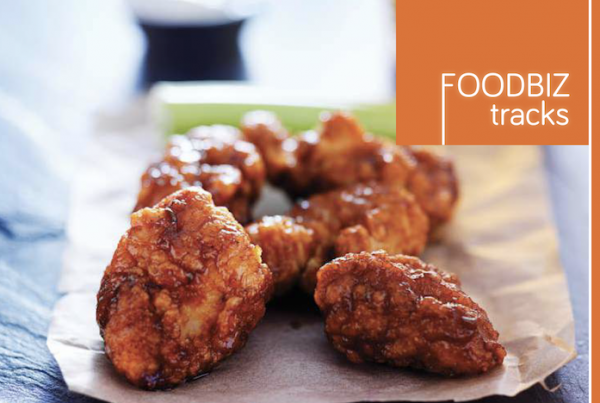Since embarking on this issue on cafe culture; we have picked up so many definitions and ideas about coffee. Some familiar and some totally new to us! We admit the list is exhaustive but here’s some of the basics that we think are helpful when thinking of operating a coffee-centric establishment.
THE BEANS
Arabica: although more than 65% of the world’s coffee is Arabica, the taste differs according to location of cultivation. You might taste berries in Ethopian coffee, chocolate or citrus in Central America and earthy notes in Indonesia and India. The plant thrives best at low altitudes.
Robusta: its plant produces more fruit and is more disease-resistant, preferring lower altitudes areas like Africa, Indonesia, Papua New Guinea and Latin America. It has twice as much caffeine than Arabica thus is something to remember when preparing coffee.
Specialty Coffee: describes beans of the best flavour produced in special microclimates with flavours attributed to the soil’s special characteristics and composition. The Specialty Coffee Association of America (SCAA) grades “specialty”coffee as those between 80-100 points.
Single Origin: George Howell founded the Cup of Excellence competition awarding the best coffee from a specific farm. People started paying more attention to the entire process from grading, harvesting, roasting and cupping. Over the years, the definition has expanded to include beans from a collection of farms from the same region that are processed at a single central mill.
Blend: Combination of various types of beans are roasted to bring up a new flavour profile. Sometimes crops are combined before roasting or done post-roast when beans of different size, density and moisture are combined.
Cupping: practice of observing tastes and aroma of brewed coffee to measure aspects of the coffee’s taste in terms of its body (mouthfeel), sweetness, acidity (a sharp and tangy feeling), flavour (the characters in the cup), and after taste.
BREWING METHODS
Pressure: espresso is made by forcing pressurised, boiling water through ground coffee and is done within 25-30 seconds for a cup. A do-it-yourself and less expensive pressure method is the moka pot. Using steam pressure that is lower (1 Barr vs 9 Barr), the coffee is brewed on a stovetop. It is still bold in flavour but would lack crema and oils.
Drip Brew / Filtered Coffee / Pour-Over
Coffee is brewed by pouring hot water over roasted, ground coffee beans in a filter and allowed to seep through the coffee. Gravity does its work as the coffee drips down into the vessel. Popular drippers in the market are:
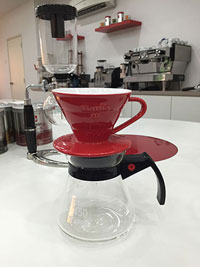 V60 Dripper with spiral ridges along its inner wall and a single, large opening at the bottom prevents the filter from sticking to the walls of the cone for improved extraction at the bottom and sides of the filter.
V60 Dripper with spiral ridges along its inner wall and a single, large opening at the bottom prevents the filter from sticking to the walls of the cone for improved extraction at the bottom and sides of the filter.
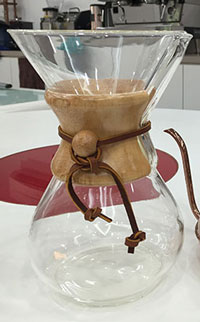 Chemex Glass Decanter with an ultra thick paper filter set placed against the walls for filtration.
Chemex Glass Decanter with an ultra thick paper filter set placed against the walls for filtration.
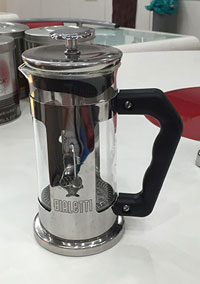 French Press: Typically used by home users, coffee is brewed by placing coarsely ground beans in the beaker and adding hot water to brew. Depending on the size of the press, it takes 2-4 minutes and then the plunger is pressed to separate the grounds; holding them at the bottom of the beaker to pour out the brew.
French Press: Typically used by home users, coffee is brewed by placing coarsely ground beans in the beaker and adding hot water to brew. Depending on the size of the press, it takes 2-4 minutes and then the plunger is pressed to separate the grounds; holding them at the bottom of the beaker to pour out the brew.
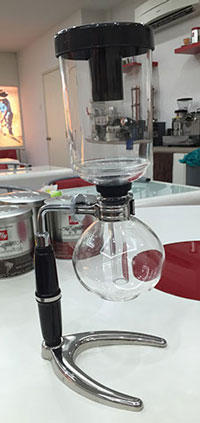 Siphon: Two chambers where vapour pressure and vacuum meet to produce coffee was invented by Loeff of Berlin in the 1830s. Water is heated in the lower vessel until expansion pushes it up the narrow tube into the upper vessel where the coffee grounds are. Water mixes with coffee grounds, extracting flavours at a high temperature. Upon complete brewing, the heat source is removed and as water and vapour cool, gravity brings them back down into the lower chamber.
Siphon: Two chambers where vapour pressure and vacuum meet to produce coffee was invented by Loeff of Berlin in the 1830s. Water is heated in the lower vessel until expansion pushes it up the narrow tube into the upper vessel where the coffee grounds are. Water mixes with coffee grounds, extracting flavours at a high temperature. Upon complete brewing, the heat source is removed and as water and vapour cool, gravity brings them back down into the lower chamber.
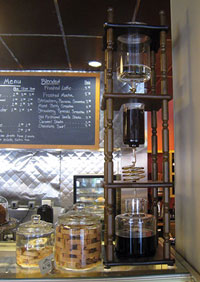 Cold Brew: Coarse-ground beans are soaked in cold or room temperature water for 8-12 hours and then chilled for 24 hours to ferment. Some might find cold brew to taste sweeter as this method is supposed to lower acidity. Also, the flavour from extraction will vary from conventional methods although the same coffee may be used.
Cold Brew: Coarse-ground beans are soaked in cold or room temperature water for 8-12 hours and then chilled for 24 hours to ferment. Some might find cold brew to taste sweeter as this method is supposed to lower acidity. Also, the flavour from extraction will vary from conventional methods although the same coffee may be used.
EDUCATION / CERTIFICATION
While there is no industr y regulations that say only certified baristas can serve coffee; many do enrol into courses to get their foundations in place. For example, both the Specialty Coffee Association of America (SCAA) and Specialty Coffee Association of Europe (SCAE) draws up a comprehensive plan where students can pick and choose. Your local coffee education academy would probably carry out training courses with SCAA and /or SCAE syllabus. The areas covered are:
SCAA
- Foundations of Coffee:a big picture of the macro and micro factors to the craft and global industry.
- Barista Pathway:level 1 teaches basics of espresso preparation, milk, and drink building and level 2 focuses on crafting coffee drinks and developing customer service skills and on-the-bar efficiency.
- Roaster Pathway:learn art and science of roasting through understanding of machine operation, safety, maintenance, and sensory applications.
- Coffee Buyer Pathway:a series of online courses designed to impart insights on navigating complexities of the supply chain.
- Coffee Taster Pathway:learn about establishing protocols, defining and protecting a coffee program. It is designed to develop both the palate and a coffee career in evaluation and analysis.
SCAE
- Introduction to Coffee:coffee’s history, farming, drying, roasting, brewing, drinking and a “coffee cupping”session.
- Barista Skills:grinder setting, making espresso, foaming and texturising milk, build skills for milk technique and latte ar t and learn about health and safety, customer service and basic business.
- Sensory Skills:learn how we perceive taste and ways to apply the knowledge, identifying specialty coffee qualities and an over view of how to implement this in business.
- Roasting Module:understand the roasting process such as roast cycle, sensory aspects, identify defects, physical changes of beans as well as workspace management and lean production.
- Brewing Module:look into the different ways of brewing coffee and learn to analyse grind profile to match the brewing method and to scientifically measure coffee strength and char t a coffee’s extraction.
- Green Coffee:understanding concepts and principles from growing the plant, processing, shipping, storage, grading, contracts, and portfolio management.
Q Grader – a license by the Coffee Quality Institute® to enable professionals to cer tify Specialty Coffee. A numerical scale from 1-100 is used to rate coffee. Each of ten attributes of a single sample of coffee is rated 1-10 and the 10 attributes makes up the total score. The program consists of 22 tests over 5-days and to pass, your scores must be well calibrated with others; meaning that you are able to consistently identify the attributes and defects of coffee samples.
NOVEL TAKES
Not everyone appreciates coffee as it is. Hence the milky variations like your basic cappucino, latte, flat white and to provide more interest to the coffee experience, here are a few trends that have popped up over the years.
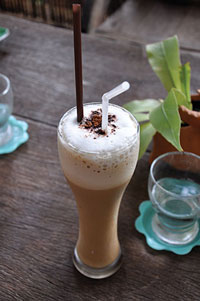 Frappe Coffee:many of us might recognise Starbucks’ ice blended Frappucino®. However, did you know that frappe has its origins in Greece? It was accidentally invented by a Dimitris Vakondios who couldn’t find hot water to make coffee so he mixed the instant coffee with cold water and ice cubes in a shaker. It became a hit! And working on the same principle, people have adopted and adapted it with Bulgarians using Coca-cola instead of water, the Danish using cold milk while Serbians shake their instant coffee with ice-cream. (Image by Krabiman on Flickr)
Frappe Coffee:many of us might recognise Starbucks’ ice blended Frappucino®. However, did you know that frappe has its origins in Greece? It was accidentally invented by a Dimitris Vakondios who couldn’t find hot water to make coffee so he mixed the instant coffee with cold water and ice cubes in a shaker. It became a hit! And working on the same principle, people have adopted and adapted it with Bulgarians using Coca-cola instead of water, the Danish using cold milk while Serbians shake their instant coffee with ice-cream. (Image by Krabiman on Flickr)
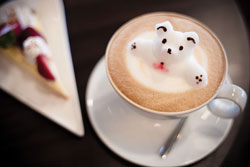 3D Latte Art:have you taken the art on your regular latte for granted? Baristas are taking it up a notch and you’ll get a teddy bear popping out of your latte! Artists like Kohei Matsuno started experimenting with milk and foam to create the three dimension art but working with something as delicate as foam takes speed and precision. The art has to be completed within 5 minutes as foam will keep breaking down, making it difficult to draw the finer details which is done by a toothpick and a spoon. (Image by Wong Kenny)
3D Latte Art:have you taken the art on your regular latte for granted? Baristas are taking it up a notch and you’ll get a teddy bear popping out of your latte! Artists like Kohei Matsuno started experimenting with milk and foam to create the three dimension art but working with something as delicate as foam takes speed and precision. The art has to be completed within 5 minutes as foam will keep breaking down, making it difficult to draw the finer details which is done by a toothpick and a spoon. (Image by Wong Kenny)
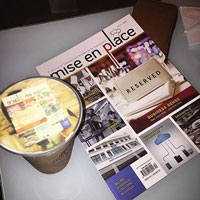 Printed Art:instead of a barista pouring milk to create latte art, a 3D printing technology combined with an ink-jet system is able to print out choice pictures atop the coffee. Customers can upload a picture from their phone or take a photo at the shop and within 10 minutes have coffee with a colourful photo. The effect lasts longer on an iced coffee though.
Printed Art:instead of a barista pouring milk to create latte art, a 3D printing technology combined with an ink-jet system is able to print out choice pictures atop the coffee. Customers can upload a picture from their phone or take a photo at the shop and within 10 minutes have coffee with a colourful photo. The effect lasts longer on an iced coffee though.







